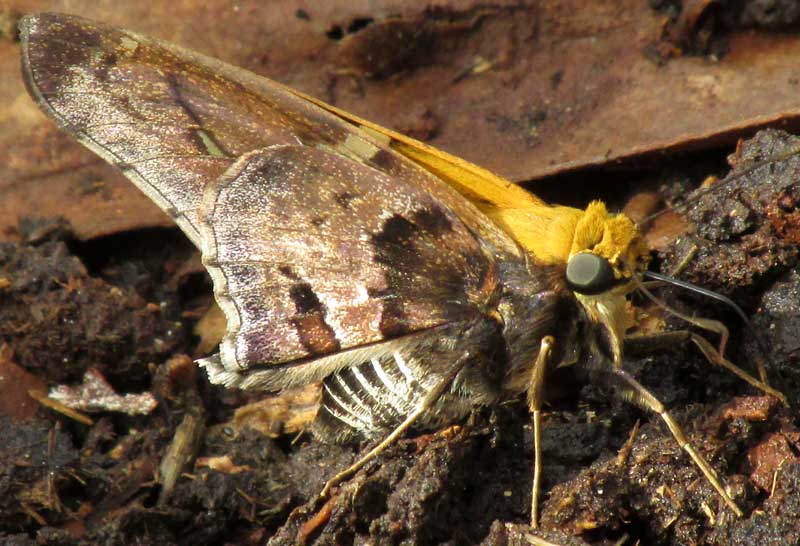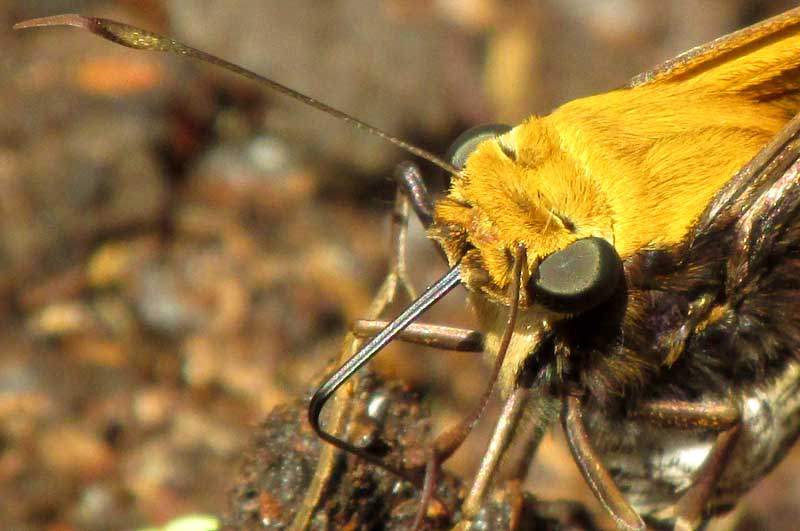Excerpts from Jim Conrad's
Naturalist Newsletter
from the June 14, 2018 Newsletter issued from Rancho Regenesis in the woods ±4kms west of Ek Balam Ruins; elevation ~40m (~130 ft), N~20.876°, W~88.170°; central Yucatán, MÉXICO
MYSTERIOUS FLOOD OF MERCURIAL SKIPPERS
Last Monday morning I went out to water the garden and was surprised to discover flitting about dozens of skipper-type butterflies I'd never seen before. Skippers are recognized by their plump bodies with broad heads, hooked antennae, and wings that are surprisingly small for such sturdy bodies. Skippers are fast fliers, and when most species land they quickly fold their stubby wings over their backs. Most skipper species are dark with white spots, and fairly similar to one another, as you can verify at the bottom of our Yucatan Butterfly Identification Page at ../yucatan/mariposa/
Below, you can see that Monday morning's skippers were spectacularly different from those look-alike species:

What a treat to meet a skipper with such a bright yellow head and back, and pale chest! That morning, they were sipping moisture from the manured soil I'd just watered, and one was so engrossed in his activity that a fine close-up of the head was possible, shown below:

Of course these pictures went off to volunteer identifier Bea in Ontario, who in just a couple of hours got back with her ID: Here we have PROTEIDES MERCURIUS, the Mercurial Skipper, distributed from Argentina north through Central America to Mexico and the Caribbean Area, with strays sometimes turning up as far north as Florida, Louisiana and Texas. Its caterpillars feed on tree and vine members of the Bean Family, and the adults feed on flower nectar. The "Butterflies and Moths of North America" webpage for the species says that it's found near streams in lowland tropical forests, particularly in edges and openings, despite us having no streams in the northern Yucatan.
This sudden outbreak of Mercurial Skippers is something of a mystery. They feed on species of the Bean Family, which is the most commonly represented group of woody plants we have here, and their great distribution area suggests that the species is adaptable. So, why haven't I seen Mercurial Skippers in recent years? And why so many right now?
My guess is that in the past we didn't see them here in the interior except maybe around sinkholes with water in their bottoms, but nowadays papaya plantations are appearing in the neighborhood employing extensive irrigation systems that deliver water pumped from the aquifer, creating moist soil the species normally finds near streams. This time last year at the rancho we didn't have the big solar-powered water-pump we use now and didn't water as frequently, but now usually we have someplace the Mercurial Skippers' required moist soil.